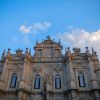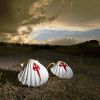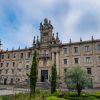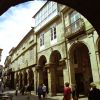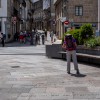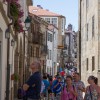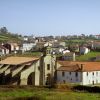- Accede I
- Regístrate I
- carrito
06. Plaza de la Inmaculada
06. Plaza de la Inmaculada

Esta plaza constituye el último tramo urbano del llamado Camino Francés. Todo peregrino que recorre esta ruta hace su entrada a esta plaza desde la llamada Puerta del Camino. Durante siglos los peregrinos a su llegada, y momentos antes de entrar en la catedral, se desprendían aquí de sus ropas y harapos y se lavaban en la antigua fuente de “Fons Mirabilis”, hoy trasladada al claustro, para que, una vez purificados, pudiesen recibir a Dios y convertirse en hombres nuevos.
En plena Edad Media, el ambiente de esta plaza bullía de actividad. Los cambistas de dinero, dispuestos a permutar a los peregrinos sus monedas por cualquier objeto de valor, se mezclaban con los vendedores de calzado, cuero, especias, y posaderos que ofrecían alojamiento a los miles de peregrinos recién llegados a la ciudad.
La concha era el elemento más buscado por todo peregrino. Símbolo de haber concluido con éxito la peregrinación, era el emblema de protección para el camino de vuelta, ya fueran las vieiras naturales del océano o sus réplicas de estaño, plomo o plata. Tal era su demanda, que pronto surgió una verdadera industria de falsificación a lo largo del Camino, al margen del estricto monopolio del gremio compostelano y del Arzobispado.
La Plaza de la Inmaculada, popularmente conocida como Azabachería, se relaciona tradicionalmente con la presencia de talleres dedicados a la talla del azabache. En los soportales cercanos encontramos las covachuelas, tiendas alquiladas por el Arzobispado a los artesanos, donde aún hoy se venden sus piezas de azabache.
Precisamente Galicia no es productora de este material duro, negro y susceptible de pulimento que llega en exclusiva desde Asturias. Pero la maestría de varios siglos de tradición ha hecho más que reconocida la labor de los artesanos de esta tierra, que desde el medioevo vieron cómo sus amuletos, llamados figas -una mano de azabache con el puño cerrado usada contra el mal de ojo- adquirían gran popularidad.
La primitiva fachada norte de la catedral muestra hoy trazas barrocas y neoclásicas, pues fue reformada por entero en el siglo XVIII. Había sido en la Edad Media una de las más hermosas del edificio. El Códice Calixtino, obra recopilada hacia mediados del s. XII, la describe como ‘la Puerta del Paraíso’, no sólo por su belleza, sino porque representaba un programa iconográfico basado en la historia de Adán y Eva, el pecado original y la redención.









